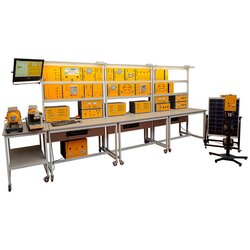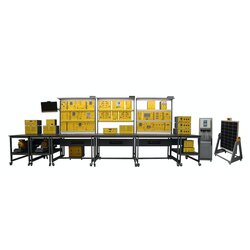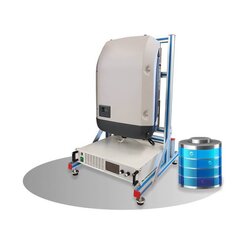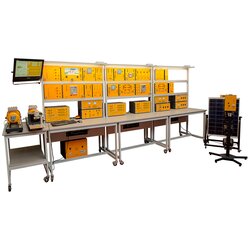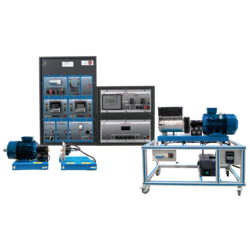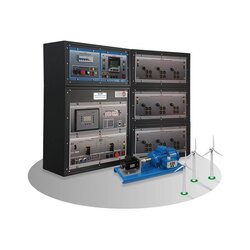Smart Grid Labs & Training Equipment
Sort by
Learn more about Smart Grid Labs
In this section you will learn more about Smart Grid Labs and Micro Grid Labs, and how they are used to teach learners about energy generation, transmission and storage.
What is a Smart Grid Lab?
A smart grid lab is a specialized facility equipped with tools, software, and systems designed to study, develop, and test the technologies that make up modern smart grid infrastructure. Smart grids are advanced electricity networks that integrate digital communication and control technologies to enhance the reliability, efficiency, and sustainability of energy distribution.
A smart grid lab provides a controlled environment for researchers, engineers, and students to experiment with different components of smart grids, such as renewable energy integration, grid automation, energy storage, demand response, and cybersecurity. These labs are essential for innovating and training in the rapidly evolving field of energy management.
What Type of Smart Grid Lab Equipment Exists?
Smart grid labs are equipped with a variety of specialized tools and systems that reflect the complexity of modern power grids. Some common types of equipment include:
Power System Simulators:
- Real-Time Digital Simulators (RTDS): These simulate the dynamic behavior of electrical power systems in real-time, allowing for the testing of smart grid control algorithms and protection schemes under various scenarios.
- Grid Emulators: Hardware-based platforms that emulate different grid conditions, enabling the study of how smart grid technologies interact with the actual grid.
Renewable Energy Integration Systems:
- Solar PV Simulators: Simulate the output of photovoltaic systems under different environmental conditions, allowing for the study of solar energy integration into the grid.
- Wind Turbine Simulators: Enable the testing of wind energy systems and their interaction with the grid under various wind conditions.
Energy Storage Systems:
- Battery Storage Units: Real or simulated battery systems used to study the integration of energy storage into the grid, focusing on charge/discharge cycles, efficiency, and grid support functions.
- Supercapacitor Systems: Explore the use of supercapacitors for short-term energy storage and rapid response to grid demands.
Advanced Metering Infrastructure (AMI):
- Smart Meters: Devices that measure and communicate electricity usage in real-time, providing data for grid management and demand response programs.
- Data Concentrators and Communication Devices: Facilitate the collection and transmission of data from smart meters and other grid sensors to central control systems.
Grid Automation and Control Systems:
- SCADA Systems: Supervisory Control and Data Acquisition systems for monitoring and controlling the smart grid’s components in real-time.
- Distribution Management Systems (DMS): Software platforms used to optimize the operation of distribution networks, including voltage regulation and fault management.
Demand Response and Load Management Tools:
- Home Energy Management Systems (HEMS): Simulate residential energy consumption and allow for testing of demand response strategies that adjust power use based on grid conditions.
- Load Simulators: Devices that mimic the behavior of various types of electrical loads, used to study demand response and load shifting techniques.
Cybersecurity and Communication Networks:
- Cybersecurity Testbeds: Platforms for testing the resilience of smart grid systems against cyber-attacks, focusing on protecting critical infrastructure.
- Communication Protocol Simulators: Test and validate the communication protocols used in smart grids, such as IEC 61850, DNP3, and Zigbee.
Electric Vehicle (EV) Integration Systems:
- EV Charging Station Simulators: Test the integration of electric vehicles into the grid, focusing on load management and vehicle-to-grid (V2G) technologies.
- Battery Management Systems (BMS): Explore how EV batteries interact with the grid for both charging and energy storage purposes.
Why Use a Smart Grid Lab?
Smart grid labs are critical for several reasons:
-
Research and Development: They provide a controlled environment where new smart grid technologies can be developed, tested, and refined before deployment in real-world systems. This is essential for innovation in grid management, renewable energy integration, and energy storage solutions.
-
Education and Training: Smart grid labs offer hands-on learning opportunities for students, engineers, and technicians, preparing them for careers in the energy sector. These labs help bridge the gap between theoretical knowledge and practical skills.
-
System Integration Testing: Complex smart grid systems involve the integration of various components. Labs allow for the testing of how these components work together, ensuring compatibility and efficiency.
-
Optimization of Energy Systems: By simulating different grid conditions, smart grid labs enable the study of optimization techniques for improving grid reliability, efficiency, and sustainability.
-
Cybersecurity Testing: Smart grids are vulnerable to cyber-attacks due to their digital nature. Labs provide a safe environment to test and improve cybersecurity measures to protect critical infrastructure.
-
Sustainability and Environmental Impact: Labs allow for the exploration of how smart grids can enhance the use of renewable energy sources, reduce greenhouse gas emissions, and support sustainable energy practices.
Best Practices for Using a Smart Grid Lab
To maximize the benefits of a smart grid lab, it's important to follow these best practices:
-
Comprehensive System Design: Ensure that the lab setup mirrors real-world smart grid conditions as closely as possible, including the integration of various energy sources, storage, and consumption patterns. This helps provide relevant and realistic training and testing environments.
-
Safety Protocols: Implement strict safety guidelines when working with high-voltage equipment and complex systems. Proper training on safety procedures is essential for all lab users.
-
Collaboration and Interdisciplinary Approach: Encourage collaboration between different disciplines such as electrical engineering, computer science, and cybersecurity. This interdisciplinary approach helps address the multifaceted challenges of smart grids.
-
Regular Calibration and Maintenance: Keep the lab equipment properly calibrated and maintained to ensure accurate simulations and reliable operation. Regular updates to software and hardware are also important to keep pace with technological advancements.
-
Data Collection and Analysis: Systematically collect data from lab experiments and simulations to analyze performance and outcomes. This data is valuable for refining models, improving algorithms, and understanding the behavior of smart grid systems under various conditions.
-
Scenario-Based Training: Use real-world scenarios to train students and professionals in responding to different grid conditions, such as peak demand, grid failures, or cybersecurity threats. Scenario-based training enhances problem-solving skills and preparedness.
-
Continuous Learning and Adaptation: Stay updated with the latest trends and technologies in smart grids. Continuously adapt the lab’s capabilities and curriculum to include emerging topics like artificial intelligence in grid management, blockchain for energy trading, and advanced energy storage technologies.
-
Industry Partnerships: Collaborate with industry partners to ensure the lab’s activities align with current industry needs and standards. This helps in providing relevant training and research opportunities that directly benefit the energy sector.
By following these best practices, smart grid labs can serve as powerful tools for advancing knowledge, fostering innovation, and preparing the next generation of energy professionals for the challenges of modern energy systems.
